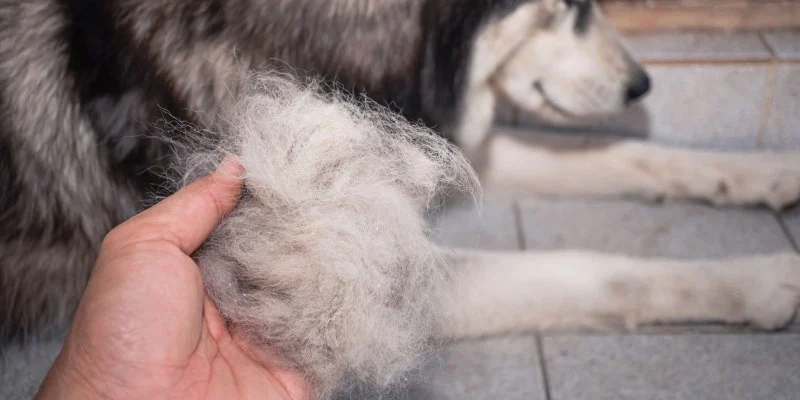
- How Seasonal Shedding Affects Pet Health and What to Do
- 1. Understanding Seasonal Shedding in Pets
- 2. Why Does Seasonal Shedding Occur?
- 3. How Seasonal Shedding Affects Pet Health
- 4. How to Manage Seasonal Shedding in Pets
- 5. Grooming Tips for Pets During Shedding Seasons
- 6. Explore Products with Pet & Puppy
How Seasonal Shedding Affects Pet Health and What to Do
Seasonal shedding is a natural part of a pet’s life cycle, but it can sometimes be overwhelming for pet owners, especially when dealing with hair everywhere. While shedding is a normal process, it can also be a sign of changes in your pet’s health. In this article, we’ll dive into why seasonal shedding occurs, how it can affect your pet's health, and what you can do to manage it effectively, ensuring that both you and your furry friend stay comfortable during these changes.

Bell Equine Surgery & Lameness
2376 Weisenberger Mill Rd, Midway, KY 40347, USA
1. Understanding Seasonal Shedding in Pets
Seasonal shedding refers to the natural process where pets shed their fur in response to changes in the environment, such as temperature or daylight. Just like how animals grow thicker coats in the winter and shed in the spring, pets undergo shedding cycles based on the seasons. However, it can vary depending on your pet’s breed, age, and overall health.
1.1. How Seasonal Changes Trigger Shedding
As the weather warms up, pets shed their winter coats to prepare for the hot summer months. Conversely, in the fall, they grow thicker coats to stay warm in the colder weather. This process is controlled by their internal biological clock, responding to factors such as light and temperature changes.
1.2. Breeds Prone to Heavy Shedding
Some pets, particularly long-haired breeds like Huskies, German Shepherds, or Golden Retrievers, tend to shed more during seasonal changes. Short-haired breeds, such as Beagles and Boxers, may shed less but still experience lighter shedding cycles. It’s essential to understand your pet’s shedding habits to manage it better.
2. Why Does Seasonal Shedding Occur?
Shedding is a natural and necessary process that serves several functions for your pet. Understanding why this happens can help you manage your pet’s health and comfort during the shedding season.
2.1. Temperature Regulation
The most common reason for seasonal shedding is temperature regulation. In the summer, pets shed their thick winter coat to cool down, and in the winter, they grow a thicker coat for warmth. This shedding is essential for their comfort and survival in different seasons.
2.2. Sunlight and Hormonal Changes
Exposure to sunlight and changes in the amount of daylight trigger hormonal shifts in your pet’s body, leading to the shedding cycle. These hormonal changes help your pet regulate its coat’s density, ensuring it has the right protection for the season.
3. How Seasonal Shedding Affects Pet Health
While seasonal shedding is generally a normal and healthy process, it can have an impact on your pet’s overall well-being. Let’s explore how shedding might affect your pet’s health and what to look out for.
3.1. Dry or Itchy Skin
As your pet sheds its fur, they may experience dryness or itching, especially in the winter months when indoor heating systems dry out the air. This can lead to discomfort, excessive scratching, or even skin irritation.
3.2. Allergies and Respiratory Issues
Pet hair and dander are common allergens, and excessive shedding can worsen allergic reactions in sensitive individuals. If you or someone in your household suffers from allergies, it’s important to manage your pet’s shedding and maintain a clean environment.
3.3. Risk of Matted Fur
Pets with longer fur are particularly susceptible to mats and tangles during shedding seasons. These mats can pull at your pet's skin, causing discomfort and, in some cases, leading to infections if not properly managed.
4. How to Manage Seasonal Shedding in Pets
Managing seasonal shedding requires a combination of grooming, diet, and sometimes extra care. Here are some effective ways to reduce the impact of shedding on your pet and your home.
4.1. Regular Grooming
Brushing your pet regularly is the most effective way to manage shedding. Regular grooming helps remove loose fur and reduces the amount of hair that ends up around your home. For long-haired pets, daily brushing during shedding season is recommended, while short-haired pets may require brushing once or twice a week.
4.2. Bathing and Skin Care
Bathing your pet with a mild, pet-safe shampoo can help remove dead fur and alleviate itching. Be sure to moisturize their skin to prevent dryness and irritation, especially during the colder months. Regular bathing can also help control shedding by clearing away loose hairs.
4.3. Proper Nutrition
A well-balanced diet with essential fatty acids, such as Omega-3s, can help improve your pet's skin and coat health, reducing excessive shedding. Consult your veterinarian for recommendations on supplements or food that can support your pet’s overall health.
5. Grooming Tips for Pets During Shedding Seasons
Grooming is not only important for managing shedding, but it also provides an opportunity to monitor your pet’s skin and overall health. Here are some grooming tips for pets during shedding seasons:
5.1. Use the Right Tools
Make sure you’re using the right brushes for your pet’s coat type. A slicker brush is great for long-haired pets, while a bristle brush works well for short-haired breeds. You can also invest in a de-shedding tool for heavy shedders.
5.2. Regularly Check for Skin Issues
While grooming, check for signs of irritation, such as dry patches, hot spots, or rashes. If you notice any unusual skin issues, consult your veterinarian to prevent further complications.
6. Explore Products with Pet & Puppy
At Pet & Puppy, we offer a variety of grooming tools, supplements, and skin care products to help manage your pet's shedding. From high-quality brushes to pet-friendly shampoos, explore our collection to make shedding season easier for both you and your pet.








 VCA Swengel Animal Hospital4.0 (183 reviews)
VCA Swengel Animal Hospital4.0 (183 reviews) Metazotics Chandler4.0 (141 reviews)
Metazotics Chandler4.0 (141 reviews) Animal Hospital South Inc4.0 (115 reviews)
Animal Hospital South Inc4.0 (115 reviews) The Bird Shoppe4.0 (421 reviews)
The Bird Shoppe4.0 (421 reviews) PetVet Vaccination Clinic0.0 (0 reviews)
PetVet Vaccination Clinic0.0 (0 reviews) VIP Petcare Vaccination Clinic0.0 (0 reviews)
VIP Petcare Vaccination Clinic0.0 (0 reviews) Behind the Scenes of a Veterinary Clinic: What Happens in 24 Hours
Behind the Scenes of a Veterinary Clinic: What Happens in 24 Hours Top 10 Mistakes New Pet Owners Make & How to Avoid Them
Top 10 Mistakes New Pet Owners Make & How to Avoid Them How to Read the Guaranteed Analysis on Pet Food Labels – A Guide for Pet Owners
How to Read the Guaranteed Analysis on Pet Food Labels – A Guide for Pet Owners How to Build Confidence in a Shy Pet: Effective Tips and Techniques
How to Build Confidence in a Shy Pet: Effective Tips and Techniques Heatstroke Prevention: How to Keep Pets Cool in Summer
Heatstroke Prevention: How to Keep Pets Cool in Summer Natural Remedies vs Vet Treatments: Making the Right Choice for Your Pet
Natural Remedies vs Vet Treatments: Making the Right Choice for Your Pet